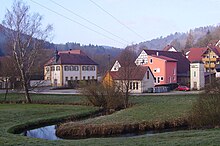Burggrub (Heiligenstadt in Upper Franconia)
Burggrub is a district of Heiligenstadt in the Bamberg district in Franconian Switzerland .
The castle of Count Stauffenberg , built in the 15th century, is the most striking building in the church village.
location

The church village with 160 inhabitants is located on the back of the Altenberg at an altitude of 378 m above sea level. NN and below the 525 meter high Eichenberg in the valley of the Leinleiter .
history
The first documentary mention comes from the year 1136.
Surname
Originally the place was just called Grub. The name stands for a valley basin. To distinguish it from the upper grub (today: Oberngrub), the designation Niederngrub was in use around 1323.
School job description (1914)
In a school job description from the assistant teacher Georg Kauper from 1914, Burggrub is described as follows:
“Burggrub, a mixed denominational village, is an independent political municipality and parish in the district and rent office and district court Ebermannstadt with 21 houses and 18 families, has 120 inhabitants; including 25 Catholics and 95 Protestants. The population does agriculture, small businesses or wage labor in the village. The post office and train station are in Heiligenstadt, the doctor and pharmacy in Ebermannstadt, the roads there are beautiful. The place is in the valley and is surrounded by the forest, there is good water. The climate is harsh, the summers are bright, while the spring and autumn are foggy. A messenger does the weekly errands in Bamberg. For unmarried teachers there is a cheap and befitting lunch menu in the Hösch inn. "
Josef Heller (1829)
In the description of the Muggendorfer Mountains by the Bamberg private scholar Joseph Heller from 1829 it says about Burggrub:
“Burggrub in the district court Ebermannstadt , denominationally mixed, is located on the Leinleiter in a pleasant valley, has 24 houses, 2 inns (the best is the one on the bridge), 143 inhabitants, including those of Rothenstein, and a small church. There used to be a Franciscan Hospitium at the same, which the Schenk von Stauffenberg donated. Burggrub was Schlüsselbergisch ; In 1350 this place was largely owned by the nobles von Schaumberg , who sold it to Voit and Peter von Streitberg around 1500 . The Streitberg Castle was destroyed in the Peasants' War in 1525, but was rebuilt soon afterwards. It burned down due to neglect in 1747 and remained in its ruins. After the extinction of this family, its goods fell back to Bamberg. In 1691 those of the Schenk v. Stauffenberg, which still has a patrimonial court there. Nearby on a free-standing, split, high rock stood the Rothenstein Castle. "
Incorporation
On January 1, 1971, Burggrub was incorporated into the Heiligenstadt market in Upper Franconia.
literature
- Johann Kaspar Bundschuh : Burggrub . In: Geographical Statistical-Topographical Lexicon of Franconia . tape 1 : A-egg . Verlag der Stettinische Buchhandlung, Ulm 1799, DNB 790364298 , OCLC 833753073 , Sp. 501 ( digitized version ).
- Pleikard Joseph Stumpf : Burggrub . In: Bavaria: a geographical-statistical-historical handbook of the kingdom; for the Bavarian people . Second part. Munich 1853, p. 579-580 ( digitized version ).
- Dieter Zöberlein: Community chronicle Markt Heiligenstadt i. OFr. - Published on the occasion of the celebration of the 450th anniversary of the granting of market rights to Heiligenstadt i. OFr. Heiligenstadt 1995.
Web links
Individual evidence
- ↑ a b Dieter Zöberlein: Community chronicle market Heiligenstadt i. OFr.
- ↑ Dieter Zöberlein: The von Streitberg, history of a Franconian noble family , self-published, Burggrub 2018, part 2, pp. 161–182 and pp. 335–346.
- ^ Wilhelm Volkert (ed.): Handbook of Bavarian offices, communities and courts 1799–1980 . CH Beck, Munich 1983, ISBN 3-406-09669-7 , p. 451 .
Coordinates: 49 ° 53 ' N , 11 ° 8' E


